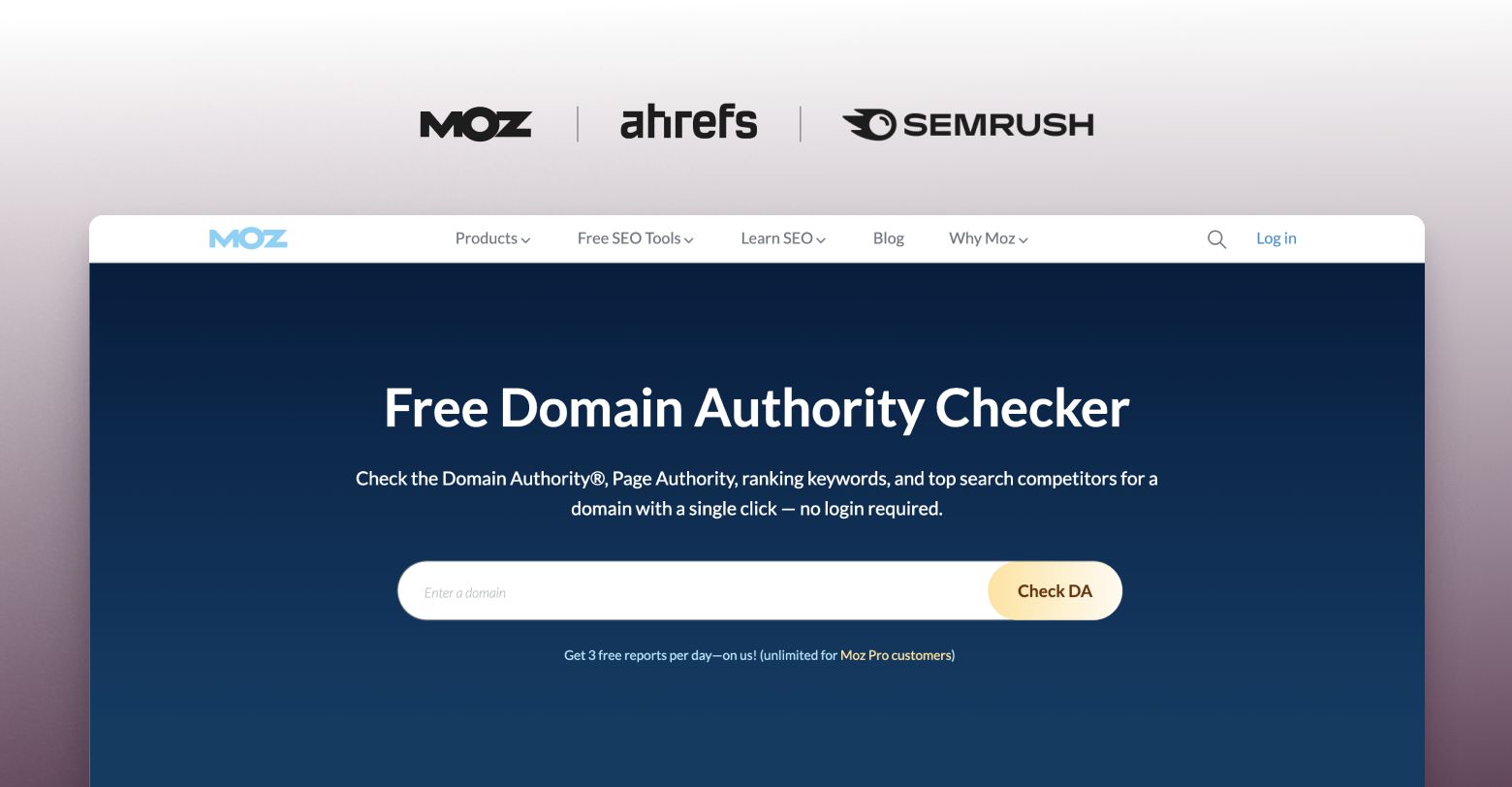Domain authority—if SEO were as simple as checking a score, agencies could focus solely on hitting that magic number, right? But while DA is not a ranking factor for Google, and
debates persist about the legitimacy of this metric, it remains one of the most popular metrics in SEO. Introduced by
Moz, DA provides a way to estimate a website's strength compared to competitors, making it a practical measure for agencies to gauge progress and identify opportunities. For example, tracking changes in a client’s DA score over time can help pinpoint the impact of new backlinks or identify when competitors gain an edge.
While not perfect, DA gives agencies a way to simplify complex SEO efforts into measurable outcomes that resonate with clients.
In this article, we’ll explore how to select the most effective DA checker for your needs and use it as a tool to enhance client success.
The history of Domain Authority
As previously mentioned, Domain authority (DA) was introduced by Moz as a metric to estimate how likely a website is to rank in search engine results pages (SERPs). It was developed as a response to the complexity of Google's ranking algorithms and was modeled after Google's now-defunct PageRank system, which evaluated the quality and quantity of a page's backlinks. Moz's DA score quickly gained popularity, providing SEOs with a reliable way to benchmark website performance when PageRank was no longer accessible. Over time, DA has evolved, with updates like the 2019 overhaul that enhanced its correlation with SERP rankings using advanced machine learning algorithms.
Despite its widespread adoption, domain authority has been met with skepticism. Critics argue that focusing too heavily on DA can lead to misguided SEO strategies, and Google has explicitly stated that DA is not a ranking factor. Nevertheless, it remains a favored metric due to its simplicity and ability to provide competitive insights. Alternatives like
Ahrefs'
Website “Authority” Checker and
SEMrush's Website Authority Checker have since entered the market, but Moz's DA continues to hold its place as a standard tool in the SEO community.
What is Domain Authority, and why is it important?
In short, a metric developed by Moz to predict how likely a website is to rank on search engine results pages (SERPs). It assigns a score from 1 to 100, with higher scores indicating a stronger likelihood of ranking. DA is calculated using various factors, including the quality and quantity of inbound links, link diversity, and domain trustworthiness.
But it’s not a ranking factor.
Let’s be perfectly clear on that.
However, it is widely used in the SEO community to assess a site’s
relative strength compared to competitors.
For agencies, domain authority is important because it provides a clear and quantifiable way to track SEO efforts and communicate progress to clients. Monitoring DA helps identify opportunities for improving link-building strategies, addressing gaps in competitive positioning, and showcasing measurable growth. While DA should not be the sole focus of an SEO strategy, it serves as a valuable benchmarking tool, helping agencies create data-driven plans to boost their clients’ online visibility.
Domain Authority vs. Page Authority
While domain authority evaluates the strength of an entire domain, page authority (PA) focuses on the ranking potential of an individual page. Like DA, PA is scored on a scale from 1 to 100 and is calculated using similar factors, such as backlink profiles and page-specific signals.
For agencies, understanding the distinction between DA and PA is critical. DA provides insights into the overall health and strength of a domain, making it useful for long-term strategy and competitive analysis. On the other hand, PA is ideal for evaluating the performance of specific content, such as blog posts or landing pages, and for fine-tuning individual SEO efforts. Leveraging both metrics together allows agencies to craft well-rounded strategies that address both broad and page-specific opportunities.
Common misconceptions
Domain authority (DA) often gets tangled up in SEO myths that refuse to die. Let’s clear the air and tackle the most common ones:
- "Google uses DA for rankings": Nope, Google doesn’t even glance at DA. It's Moz’s baby, not a Google-sanctioned metric.
- "Boost DA, boost rankings":
Not quite. DA is relative, so unless it outshines competitors, rankings won't budge.
- "More links = better DA":
Only if those links are high-quality. A flood of spammy links won't do you any favors.
How do you calculate Domain Authority, and what’s a good DA score?
Domain authority (DA) is calculated using Moz’s
proprietary algorithm, which evaluates multiple factors to estimate the strength of a domain. Some of the key elements include the quality and quantity of inbound links, the diversity of linking domains, and signals related to domain trust. A machine learning model processes these inputs to predict a site’s likelihood of ranking relative to others, producing a score between 1 and 100.
The scoring is logarithmic, meaning it’s easier to grow from a DA of 10 to 20 than from 70 to 80.
DA is relative, so there’s no universal "good" DA score, but it’s helpful to compare against competitors in each niche. because the "goodness" of a score depends on the industry and competitors. For example, a DA of 30 might be excellent in a niche with low competition, while in highly competitive fields, a score of 50 or higher could be necessary to stand out.
Ultimately, DA is best used as a comparative and tracking tool rather than an end goal, ensuring your clients’ websites are positioned to outperform their competitors.
Top Domain Authority tools to try
When managing clients’ websites, tracking domain authority (DA) is a strategic way to demonstrate SEO progress and identify opportunities. The right tool helps you deliver clear, actionable insights. Here are some top domain authority tools tailored for agency workflows:
1. Moz’s Domain Authority Checker
As the originator of the DA metric,
Moz provides the most accurate and widely used checker. Their
Link Explorer delivers DA scores, page authority, and a detailed backlink profile, making it a go-to choice for presenting client reports.
2. Ahrefs Website Authority Checker
Although
Ahrefs uses Domain Rating (DR) instead of DA, its comprehensive insights into backlinks, referring domains, and organic traffic make it valuable for competitive analysis. And a good fir for identifying link-building opportunities for clients.
3. SEMrush Authority Score
SEMrush combines its Authority Score with backlink quality, organic traffic, and spam risks. It’s a great tool for showing clients the bigger picture of their site’s health and SEO potential.
4. Ubersuggest
Ubersuggest, developed by Neil Patel, includes a straightforward Domain Authority Checker. It’s particularly user-friendly and excellent for smaller agencies needing quick DA scores and competitor insights.
5. Rank Tracker by SEO PowerSuite
Rank Tracker evaluates “Domain Strength,” which incorporates DA and other metrics like backlinks and social signals. It’s another good option for agencies managing diverse client portfolios.
Ways to improve a site’s Domain Authority
OK, you’ve nailed down your client’s Domain Authority score—now what? Here’s how to boost DA effectively:
1. Build high-quality backlinks
Quality backlinks remain the cornerstone of improving DA. Focus on obtaining links from high-authority websites relevant to your client’s niche. This could involve guest blogging, partnerships, or simply creating content that others want to link to. Remember, it’s better to have a few high-quality links than a multitude of low-value ones.
2. Optimize technical SEO
Ensure the website is technically sound (a given if you’re using an SEO-ready website builder like Duda, hopefully)—fast loading speeds, mobile responsiveness, proper indexing, and secure HTTPS protocols are essential for both user experience and search engine performance. Search engines reward well-optimized websites, and this, in turn, can positively influence DA.
3. Produce exceptional content
Great content attracts backlinks naturally. It’s that simple!
4. Improve internal linking
Strategic internal linking helps distribute authority across your website’s pages. By linking related content together, you improve site crawlability and boost the relevance of the linked pages. Use keyword-rich anchor text and link to your most important pages.
5. Clean up toxic backlinks
Low-quality, spammy backlinks can hurt your DA. Regularly audit your client’s backlink profile to identify and disavow harmful links using tools like Google Search Console, Moz, or Ahrefs. This ensures your client’s site’s backlink profile remains healthy and trustworthy.
6. Enhance user experience (UX)
A user-friendly website with an intuitive design (again, your website builder is key here) encourages visitors to stay longer and engage more. Lower bounce rates and higher engagement metrics signal to search engines that the site provides value, which can lead to improved DA over time.
Final note: Maximizing Domain Authority for client success
As agencies, it's crucial to remember that DA isn't a magic bullet that guarantees higher rankings, but a valuable benchmark for tracking your client’s SEO progress. By consistently improving key factors like backlinks, content quality, and user experience, you can steadily raise your client’s DA and see the positive impact on their overall SEO performance.
When it comes to reporting DA to clients, focus on progress rather than perfection. A great way to approach this is by setting a baseline DA score at the beginning of your work together and tracking changes over time. For a more impactful report, break down the factors affecting DA—like backlinks, content, or site structure—so clients can see exactly where improvements are being made. Visual tools like graphs or a side-by-side comparison of DA scores over specific intervals make the data clearer. You can also align DA progress with other performance metrics like organic traffic growth, keyword rankings, and conversion rates to show a full picture of the SEO efforts.
In your reports, always explain that DA is just one part of the SEO puzzle. When clients understand the broader context and how DA fits into their website’s overall strategy, they’ll appreciate its value as a long-term indicator of success.








